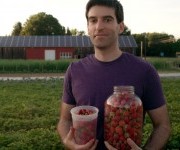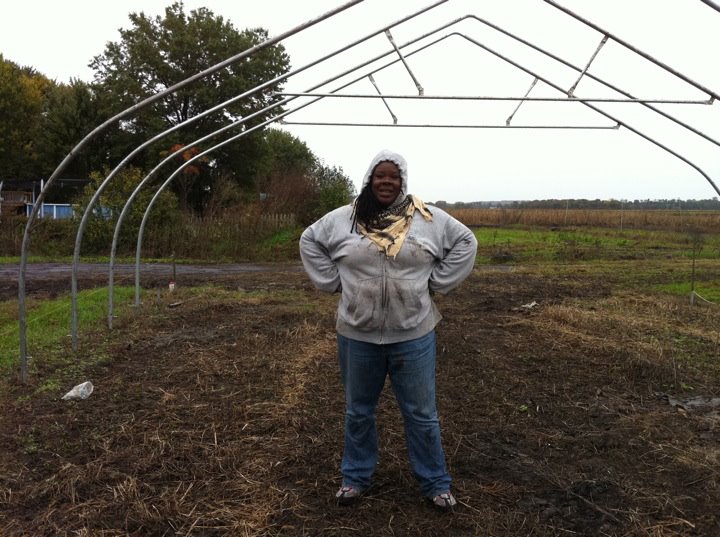Grist is proud to present the Change Gang — profiles of people who are leading change on the ground toward a more sustainable society and a greener planet. Some we’ve written about before; some are new to our pages. Some you’ll have heard of; most you probably won’t. Know someone we should add to the Change Gang? Tell us why.
Kristofor Lofgren says he never imagined “in a billion years” that he would end up trying to save the world as “the proprietor of a sushi restaurant.” After graduating from U.C. Berkeley, having majored in political science and American studies, he headed to law school in Oregon. He envisioned himself one day as a lawyer working for a crusading environmental organization.
But along the way he wound up investing in a sushi restaurant in Portland, Ore., as a side project. When business faltered, and his partners were unreceptive to his suggestion that they reorganize the restaurant around the concept of sustainability, he bought them out and set forth to change the world, one fish at a time.
“I felt like I could do more good for the environment and more good for society by running a socially and environmentally responsible business,” says Lofgren.
Lofgren isn’t thinking small. He believes the entire restaurant sector — a $500 billion-a-year industry — is ripe for transformation, and he plans on playing a major role. Lofgren is convinced that the free market can be good for the environment. Customers who demand sustainability will push an increasing number of restaurants to require that the food they serve customers be sourced transparently and sustainably; eventually, the pressure will force food producers to change their practices. Lofgren cites with pride the example of the Asian food distributor, the Japan Food Corporation. The company already supplies Bamboo Sushi with dried goods like seaweed, but is seeking certification of its salmon by the Marine Stewardship Council, in order to supply Bamboo Sushi with fresh fish as well as the dried goods it already provides.
“True sustainability,” says Lofgren, “is the infinite perpetuation of whatever act you are doing.” For Bamboo Sushi, the principle extends to more than just ensuring that the sushi it serves is sustainable. The restaurant is also diverting a portion of its profits to funding the creation of “marine protected areas” where fishing is forbidden. Lofgren calls the strategy an example of Bamboo Sushi’s “regenerative business model” — for every fish taken out of the ocean, another gets put in.
The campaign to create marine protected areas also works to bolster Bamboo Sushi’s brand. It is critical, says Lofgren, to show his customers, “the people who have put their hard-earned money in our pockets, that we are using the money the way that we told them we would — which is to better the world.”
When Lofgren gets into his spiel –“we want to make the right decision the easy decision” — he begins to sound more like a Silicon Valley startup entrepreneur than your typical restaurant guy. But get him talking about the oceans, and the passion pours out.
Making the case for sustainability isn’t hard at all, he says. Fish raised sustainably simply taste better — “fish that are caught with a lot of care in a more artisanal fashion taste better than fish caught in a massive net, in which all of the fish are struggling and stressed out and tearing their muscle fibers.” What’s more, the very nature of the fishing trade makes dealing directly with those “artisanal” small-scale fishermen more sensible than buying from a middleman.
“With food,” says Lofgren, “the more people that touch it, the more rotten it becomes, and the more people all have to have their piece of the pie. So you’re not only making the food worse quality but you’re also making it more expensive. That is a very inefficient model.”
Lofgren’s three-year-old restaurant has been growing at a 35 percent annual clip since inception, he says, and plans are afoot for new outlets in Portland and the Bay Area. But in a context where the oceans are already severely overfished, and the world’s population continues to boom, an obvious question arises: Is it physically possible to feed the world’s burgeoning appetite for fresh fish? If everyone in China eats sushi at the same rate as they do on the West Coast, can the oceans keep up?
Lofgren has clearly mulled this question before; he launches quickly into a two-part disquisition. Part one is reducing the huge amount of waste in the seafood food chain. Twenty-five to 35 percent of the fish that are caught “never make it to someone’s mouth,” says Lofgren. “There are big problems with transportation, licensing, and proper fishing methods; bycatch obviously is a huge, huge issue, as is the lack of cold storage in developing countries.” Those problems, he believes, are the “low-hanging fruit.”
But the second part of Lofgren’s answers may raise hackles with environmentalists who are worried about the environmental effects of fish farming. “Aquaculture,” he says, “will be the dominant standard in our lifetimes.”
“Seafood is the last food in the world that we hunt for as a species. Everything else is farm-raised in some capacity.”
Lofgren is quick to note that most currently performed aquaculture does not meet his standards for sustainability (which are stricter than Whole Foods’, he stresses in a quick aside). Farmed fish need to be fed sustainably, and there can be no antibiotics, hormones, or genetically modified organisms included in the process.
“I think that if science and policymakers can get together and do it correctly, we have the ability to be able to create a very healthy source of protein for 8 billion people on this planet,” says Lofgren. “But if we don’t, and we go the way of the cattle industry, and we keep building these ponds and we fill them full of junk like genetically modified corn or soy or anything like that, well, then we have an issue.”
But change won’t happen without demand, and at least some of that demand needs to come from the restaurant industry.
“Why, as an industry, should we always be behind the eight ball?” says Lofgren. “Why should we always be behind the curve? Why shouldn’t we be setting it?”



